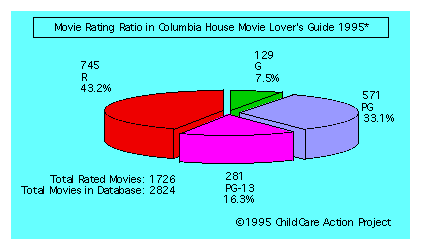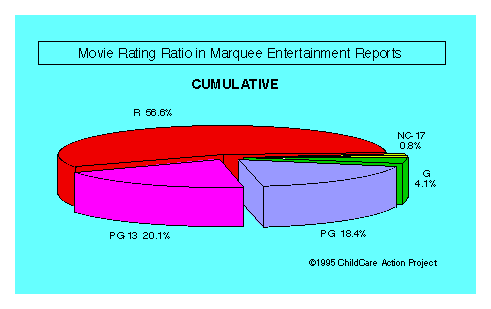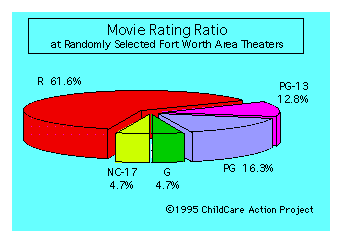ChildCare Action Project:
Christian Analysis of American Culture (CAP)
Where's the G!?
Special Report-003
Thomas A. Carder
CAP President

 ............Quick! What first comes to mind? No, not the newspaper or the 11:00 o'clock news. No, not Friday night downtown. The movies, right? Right!
............Quick! What first comes to mind? No, not the newspaper or the 11:00 o'clock news. No, not Friday night downtown. The movies, right? Right!
Movies which present these "offensive" elements are rated PG or more severe. There is approximately a 95% chance that an advertised movie has some sort of age restriction. During development of the ChildCare Action Project (CAP) Entertainment Media Analysis Model, it was very difficult to find feature-length, non-cartoon movies rated G to include in the baseline comparative database of findings. So, I resovled to find out why.
Let me present some sobering facts about the relative percentage of movies of each rating. When I am finished, you will have a new perspective of why it is hard to find a G-rated movie.
I will first share with you the rationale behind the movie ratings. Then I will inform you of the findings of three studies conducted by the CAP to reveal the percentages of rated movies commonly available, and our answer to "Where's the G!?"

A. Movie Rating Rationale
As presented in a 1957 book titled The Movies by Richard Griffith and Arthur Mayer, there were no movie rating codes in the first half of this century, just a "gentleman's agreement." The gentleman's agreement was a voluntary and self-regulating system of what should and should not be presented in movies. Later, a former postmaster general named WIll H. Hays developed the Hays Production Code. The Hays Production Code could impose fines for immoral material in movies. The Hays Production Code was a rather detailed list of do's and don'ts.
Believing the Hays Production Code to be a form of censorship, Jack Valenti of the Motion Picture Association of America (MPAA) developed a formal system of rating movies in November 1968. The MPAA rating system replaced the Hays Production Code. The MPAA rating system relies on a voluntary agreement of the movie producers to seek a MPAA rating prior to releasing a movie. The purpose of the MPAA rating system is strictly limited to warning parents: no other purpose. Only parents, states, and municipalities have the authority to restrict viewing of movies by children.
Between 1968 and 1990 the MPAA rating system underwent a few revisions. In September 1990 the MPAA rating system was finalized as it stands today. Following are the definitions of the movie ratings of the MPAA quoted from the publication of the MPAA titled The Voluntary Movie Rating System: How It Began, Its Purpose, The Public Reaction, ©1994. My comments follow the definitions in blue.
G: General Audiences -- All ages admitted(1)
"This is a film which contains nothing in theme, language, nudity and sex, violence, etc. which would, in the view of the Rating Board, be offensive to parents whose younger children view the film. The G rating is not a "certificate of approval," nor does it signify a children's film."
"Some snippets of language may go beyond polite conversation but they are common everyday expressions. No stronger words are present in G-rated films. The violence is at a minimum. Nudity and sex scenes are not present; nor is there any drug use content."
In the first sentence the MPAA claims G movies "...contain nothing in...violence..." (And what is "etc?") Then, in the fifth sentence, the MPAA claims "...violence is at a minimum." Which is it? None or at a minimum? Whatever. It would seem to me that Gaston graphically stabbing the beast in Beauty and the Beast (G) with the blade of the knife visibly entering the body of and remaining in the beast should be classed as a violent attempt to kill by stabbing! And that's just one example. I sure wouldn't want any of my toddlers or older kids trying it on one of the other kids to see if it really does kill!
PG: Parental Guidance Suggested, some material may not be suitable for children
"This is a film which clearly needs to be examined or inquired about by parents before they let their children attend. The label PG plainly states that parents may consider some material unsuitable for their children, but the parent must make the decision."
"Parents are warned against sending their children, unseen and without inquiry, to PG-rated movies."
"The theme of a PG-rated film may itself call for parental guidance. There may be some profanity in these films. There may be some violence or brief nudity. But these elements are not deemed so intense as to require that parents be strongly cautioned beyond the suggestion of parental guidance. There is no drug use content in a PG-rated film."
So sayeth the MPAA. The CAP Investigation Area Scoring and Trend Report (CAP Special Report-0001) seems to differ. Violence was clearly present. And while there were not many examples of drug usage or drug presence in the PG set of movies investigated, there was drug/alcohol usage or presence in the PG movie set! Also in accordance with the findings revealed in Special Report-0001, the Investigation Area for sex lost 17 of 100 possible points due to sex! Is that not "intense?" And the CAP language "yard stick," the Impunity/Hate Investigation Area, lost bigtime: 56 of 100 points! I would certainly call that intense!
PG-13: Parents strongly cautioned. Some material may be inappropriate for children under 13
"A PG-13 film is one which, in the view of the Rating Board, leaps beyond the boundaries of the PG rating in theme, violence, nudity, sensuality, language, or other contents, but does not quite fit within the restricted R category. Any drug use content will initially require at least a PG-13 rating. In effect, the PG-13 cautions parents with more stringency than usual to give special attention to this film before they allow their 12-year olds and younger children to attend."
"If nudity is sexually oriented, the film will generally not be found in the PG-13 category. If violence is too rough or persistent, the film goes into the R (restricted) rating. A film's single use of one of the harsher sexually-derived words, though only as an explicative, shall initially require the Rating Board to issue that film at least a PG-13 rating. More than one such explicative must lead the rating Board to issue a film an R rating, as must even one of these words used in a sexual content."
How noble! Noble that the MPAA feels that we as parents should wait until our children are 13 years old before letting them listen to vulgarity and watch nudity in movies. I dare say when most boys, 13 or older, see a glimpse of female nudity in a movie, that they are not likely going to react to the scene with sensual sobriety whether the nudity is presented in a "sexually oriented" setting or otherwise. Also, how can we as parents expect our children to not use the language we let them listen to in the movies?
R: Restricted, under 17 requires accompanying parent or adult guardian
"In the opinion of the Rating Board, this film definitely contains some adult material. Parents are strongly urged to find out more about this film before they allow their children to accompany them."
"An R-rated film may include hard language, or tough violence, or nudity within sensual scenes, or drug abuse or other elements, or a combination of some of the above..."
-- and a whole, whole lot more. What is it about R-rated material that makes it "adult?" Does it mean that I am an adult because I can watch this stuff? Or that because I can watch this stuff I am an adult? Horsefeathers! There is nothing "adult" about the material in R-rated movies. To be able to watch these movies does not make anyone an adult. I should think the classification should not be "adult" but rather should be "lewd" or "vulgar" or "indecent."
NC-17: No children under 17 admitted
(NC-17 replaces the previous X rating.) "This rating declares that the Ratings Board believes that this is a film that most parents will consider patently too adult for their youngsters under 17. No children will be admited. NC-17 does not necessarily mean "obscene of pornographic" in the oft-accepted meaning of those words. These are legal terms and for courts to decide. The reasons for the application of an NC-17 rating can be violence or sex or aberrational behavior or drug abuse or any other elements which, when present, most parents would consider too strong and therefore off-limits for viewing by their children."
I cannot comment credibly on NC-17 rated movies because, since the X rating has been replaced by the NC-17 rating, the CAP will not analyze NC-17 or more severe material.
(1) "G: General Audiences -- All ages admitted"
"PG: Parental Guidance Suggested, some material may not be suitable for children"
"PG-13: Parents strongly cautioned, some material may be inappropriate for children under 13"
"R: Restricted, under 17 requires accompanying parent or adult guardian" and
"NC-17: No children under 17 admitted"
are registered trademarks of the Motion Picture Association of America.
Now that you have a basic understanding of the rationale behind the movie rating system, let me share with you the findings of three studies conducted to reveal the relative availability of G-rated movies.

B. Availability of G-rated Movies
During the first and second calendar quarter of 1995, the ChildCare Action Project (CAP) was conducting media investigations. As part of the investigation process, the CAP developed a media scoring system. During the investigations, the CAP Investigator found it difficult to find non-cartoon(2), feature-length G-rated movies to provide relational perspective to more severely rated movies. I suspected there were relatively few G-rated movies made. To corroborate the suspicion, studies were conducted to reveal a ratio of movie ratings assigned by the Motion Picture Association of America. Following are the results of the studies.
(2)
The CAP investigations were centered around reality-style media using human actors and actresses and thus avoided cartoon material. To equate unacceptable behaviors of fantasy cartoon characters to real-life people such as those viewing the material was at best a loose connection. Therefore, the comparative baseline database for the CAP investigations did not include cartoon media.
1. Movie Rating Ratio in the The Columbia House Video Movie Lover's Guide, 1995.

This graph represents the ratio of the G, PG, PG-13, and R-rated movies in the Columbia House Video Club Movie Lover's Guide, 1995. No NC-17 or X were found. Pie data includes rated any movie listed, including feature-length cartoon movies, but no movies listed as "Not Rated." This study revealed that in 1995 there were six times as many R-rated movies available through the Columbia House Video Movie Lover's Guide than G-rated movies. Please take caution of recent Not Rated movies. Recall the revelation of the CAP Special Report-0001 regarding "Not Rated." The only Not Rated movie briefly viewed was a skin flick, and a violent one at that! Also recall that there is no requirement that any movie be rated!
2. Movie Rating Ratio in the Marquee Entertainment Network periodicals titled Marquee Entertainment Reports, May 1995 to January 1996.

This graphs represents the ratio of G, PG, PG-13, R, and NC-17 rated movies in the Marquee Entertainment Reports May 95 through January 96. Data does not include movies which were shown as "Not Rated." Any rated movie that was advertised in any report booklet, inlcuding feature-length cartoons, was included. No duplication is assured. In a cumulative sense, these figures reveal 15 times as many R-rated movies are available for rent than G-rated movies.
3. Movie Rating Ratio at Selected Fort Worth Area Theaters October 18, 1995.

This graph collectively represents the ratio of movie ratings, including feature-length cartoons, showing at ten randomly selected multiple screen theaters in the Fort Worth Metroplex area on October 18, 1995. That the same movie was showning at two locations was not incorporated into the database because of the double opportunity to see the movie. Parameters: only mutiplex theaters were included; only the phone book name of a theater was used in selection, ads were not observed; the investigator had no known previous knowledge of or experience with any theater. The figures represent 14 times as many R-rated movies as G-rated movies were available at the ten randomly selected Fort Worth area theaters.

C. Summary
Integration of the results of all three studies revealed the following ratio of MPAA movie ratings generally available:
- 55.6% were R or NC-17
- 16.4% were PG-13
- 22.6% were PG
- 5.4% were G
By simple arithmetic, more than half of the feature-length movies generally available are rated R or NC-17. And only 1 out of 18 are rated G! And, since these studies included annotation of cartoon feature-length movies, fewer than 1 out of 18 feature-length non-cartoon are available! Next time you drive by a multiplex (multiple screen) moviehouse marquee, you'll see. It would be rare for you to see a non-cartoon G-rated movie advertised.

D. Conclusion
The reason it was hard to find G-rated feature-length, non-cartoon movies is there are very few made. Of course, it might be have been logical in the beginning to assume the reason it was hard to find non-cartoon feature-length movies was that few are made, but at least now it is proven. About 5% of all feature-length movies are rated G. So now you know "Where's the G!?"

The ChildCare Action Project (CAP) is a nonprofit Christian ministry. We rely on public support. If you wish to contribute to the CAP, please send your donations to
ChildCare Action Project
Post Office Box 177
Granbury, TX 76048-0177
Tax exemption applies in accordance with Section 501(c)(3) of the Internal Revenue Service Tax Codes.
Please feel free to write to us.
You are welcome to
Go back to the CAP Reports Page
or
Top of the CAP Home Page
or
CAP Table of Contents
or leave me an email message or comment at
cap@capalert.com
Thank you for visiting us and may God bless you. Prayerfully, we will provide you with some of the most revealing commentary and investigative reporting you have ever read.
In the sweet and holy name of Jesus:
Lord, Master, Teacher, Savior, God.
Thomas A. Carder
President
ChildCare Action Project: Christian Analysis of American Culture (CAP)
Copyright ChildCare Action Project (CAP) 1996











